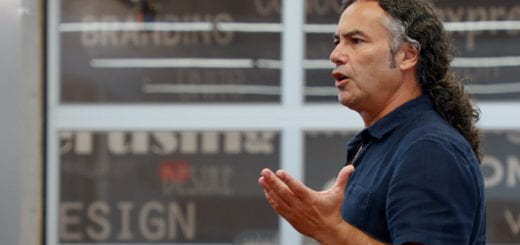Finding One’s Way: Proprioception and Biological Research

L-R: Steven Valdespino, ’19 Biochemistry, Mulatwa Haile, ’19 Biological Sciences, Katie Wilkinson, Apoorva Karekal, ’20 MS Biological Sciences. Photo by Josie Lepe.
There are between 800 and 900 muscles in the human body, and each one has anywhere from five to 50 stretch sensitive sensory neurons—cells that help the brain build a three-dimensional representation of the body in space. This sense of position in space, known as proprioception, helps people move. If sensory neurons fail, it affects how a person moves or reacts in space.
“How does your body take sensory information and use that to do the things that you need to do?” asks Katie Wilkinson, walking through her lab on the second floor of San Jose State’s Duncan Hall. The associate professor of biological sciences trains undergraduate and graduate students how to use electrophysiological tools to record activity in muscles, examine sensory neurons and study the possible applications these findings could have on healthcare and robotics.
Her team is exploring how humans use sensory information to move, balance and position ourselves—how and why the human body interacts with the world around us. Wilkinson’s lab is focused on how proprioceptors sense muscle length, when and why they fail, and explores how stretch sensors in muscles work. She hopes that the data they collect contribute to a greater understanding of how neurons communicate movement, which could aid people who have trouble with balance and movement.
Helping People Move

Sarah Chu, ’20 Microbiology, and Nikola Klier, ’20 Molecular Biology, work in Katie Wilkinson’s lab. Photo by Bob Bain.
Wilkinson hopes their research will help identify therapies for patients whose sensory neurons do not work well. Their findings could also be applied to prosthetic limbs or robotics.
“We have sophisticated robotics and prosthetic limbs, but they don’t move through the world with as much ease as humans do,” says Wilkinson. “Their senses, even with top-of-the-line sensors, are nowhere near as good as ours. We have circuits built in—some that are very quick reflexes and some that go to the brain and smooth our movement and adapt to challenging environments. Understanding the basic science of how our sensory neurons work may help us translate that into prosthetics, give people a little more sensation and perhaps a better range of movement. My lab pursues very basic science research, but hopefully some of the things we learn can contribute to that.”
There is no one answer to the questions Wilkinson’s lab are pursuing. Rather, there are sets of variables to test and analyze. When she arrived at San Jose State in 2012, Wilkinson had to build her lab from the ground up—securing funding, obtaining scientific equipment, hiring and training undergraduate and graduate students to conduct experiments. She was hired after completing an Institutional Research and Academic Career Development post-doc at Emory University that emphasized mentorship, teaching and research experience. It was important to her that she work for a university like SJSU that values teaching as much as research. By establishing her lab and hiring students, Wilkinson creates opportunities for students to hone their skills, pursue big questions and contribute to major discoveries and ongoing experiments.
“It’s really great to have the students’ energy,” says Wilkinson. “They come up with good questions that help refine what we are doing. Once they have the data, they pitch ideas, which is really important. It’s fun to see them grow as scientists.”
Building Blocks of Research
“These lab experiences really shape people’s lives and people’s experiences. I found an awesome mentor in Katie. It was really helpful. You carry that with you through life.”
—Anusha Allawala, ’15 Biomedical Engineering
One such scientist is Anusha Allawala, ’15 Biomedical Engineering, a first-generation college student who had immigrated to California from Pakistan shortly before enrolling at San Jose State. Navigating SJSU’s metropolitan campus was initially overwhelming for the aspiring scientist, who reached out to Wilkinson when she heard about the new neurophysiology lab. Allawala helped build the lab, experience she applied as a research associate at Circuit Therapeutics, a Bay Area startup that specializes in optogenetics. Thanks to Wilkinson’s lab, she knew how to use electrophysiological tools and had contributed to published research that would further the study of proprioception.
“Katie’s lab was my first exposure to recording any kind of activity from cells,” Allawala explains. “It was really fun and everything I’ve done since has involved that component of electrophysiology. All of those skills came in handy when I was working at my job because I was familiar with what the data should look like.”
Allawala was especially interested in the intersection of neuroscience and engineering, and how scientists apply technical knowledge to biological problems. How can engineers design, test and implement tools or devices that address health concerns? She was intrigued by deep brain stimulation devices, which are implanted in the brain and deliver electrical impulses to treat motor disorders such as Parkinson’s disease. In 2017, she left Circuit Therapeutics to accept a National Science Foundation graduate research fellowship at Brown University, where she is pursuing a PhD in biomedical engineering. Her work is focused on the implementation of deep brain stimulation for neuropsychiatric indications, specifically depression. She says the skills she learned in Wilkinson’s lab were fundamental to her growth as a scientist.
“It really made a difference for me to pursue research at San Jose State,” says Allawala. “We performed basic science research, information that I carry with me in life. Katie’s work builds on an understanding of how proprioception works and how sensory information is processed. This is really important for amputees and researchers focused on those areas. Sometimes biomedical research doesn’t have an impact until decades later, but that wealth of knowledge builds on itself.”
Groundbreaking Discoveries
To understand what causes neurological problems, scientists must first identify where and when they occur. How can a doctor treat a disease if it’s unclear where or how it originates? By investigating how proprioceptors sense muscle length and how stretch sensors work, Wilkinson and her team, in collaboration with Ardem Patapoutian’s lab at The Scripps Research Institute, identified the ion channel that opens when muscles stretch. This discovery, which was the cover article in a 2015 issue of Nature Neuroscience, locates where mutations that cause imbalance or neurological problems may sometimes occur. Dasha Zaytseva is one of the paper’s authors.
“Critical thinking skills, the skills to take data and make conclusions from it, are important no matter what you do. I think that’s one main reason why science education is so important.”
–Katie Wilkinson
“We helped identify that this ion channel is responsible for proprioception, which was a really big discovery,” says Zaytseva, ’16 Biological Sciences, an alumna of Wilkinson’s lab. “There are disorders of that ion channel in humans that lead to imbalance, and now there is a definitive channel that we know is responsible for that. Not only were we published, but we went on to be cited in the New England Journal of Medicine, which was an awesome experience to have as an undergrad.”
Zaytseva says working in the lab reinforced class concepts and hands-on experience with the scientific method. She was inspired to study neuroscience in part because her grandfather lived with Alzheimer’s disease, and she wants to understand how neurological disorders occur and how they might be treated. Following graduation, she received a fellowship through the California Institute for Regenerative Medicine (CIRM) to pursue a master’s in molecular biology at San Francisco State University. As part of the program, she is working in a stem cell research lab at UC Berkeley. Though she is still completing her graduate thesis, she has already been accepted to Genentech’s competitive rotation program, which offers work experience for select master’s graduates. She says that science education is critical because there will always be problems to solve, discoveries to make and techniques to perfect that could improve a person’s quality of life.
“As we get older, we are all going to potentially suffer from cancer or neurodegenerative disease or diabetes,” Zaytseva says. “These are all things that affect us personally or are in our families, which is why we should all strive to be working toward a cure. Through scientific research, we are able to get closer to helping people suffering from disease. That’s an important goal for us to have as humans.”
Wilkinson agrees. Her lab is now studying the mutations that occur in people living with distal arthrogryposis, type 5, a rare disorder that causes limb dysfunction, joint rigidity or limb deformities. The goal is to identify how sensory neurons work and pinpoint potential therapies. Together with her three master’s students and 12 undergraduates, they are applying for research grants, gathering and analyzing data, publishing papers and presenting at conferences.
While they explore ways to help people with neurodegenerative disorders achieve balance, Wilkinson is guiding generations of scientists as they find their way to careers in academia, biotech and research.
“We are doing cutting-edge science here at San Jose State,” Wilkinson says. “Students are publishing papers. They are contributing to their disciplines. It’s really important to support that because universities should be where you make new knowledge—and that’s how we train students. Teach them what science really is. It’s not memorizing stuff in a book. It’s looking at your data and figuring out what it means and why it’s important. Students leaving our lab are well-trained and competing on equal footing with students from other universities. I like working with students—that’s why I came here. San Jose State students are some of the most motivated people I’ve ever met.”



